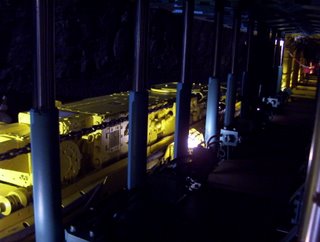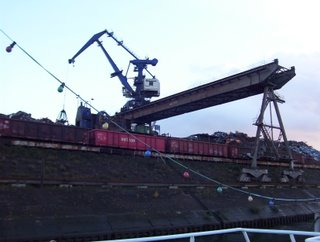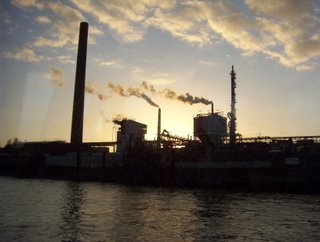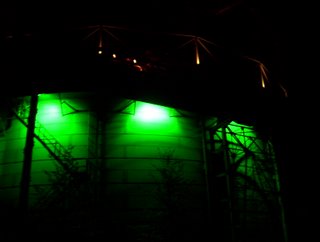Ruhrgebiet
This week I attended a mandatory three-day informational session in Düsseldorf and the surrounding area. Part of the time was spent in various meetings discussing the history of North Rhein-Westphalia and its school system. As part of the program, though, we ended up getting to visit quite a bit of the Ruhrgebiet, which, as Europe’s largest industrial and mining region, isn’t necessarily as picturesque as other parts of Germany, but is definitely an interesting place to visit.
First we visited the Bochum Bergbaumuseum, a seemingly unending collection of artifacts having to do with mining in the area. Tours of actual coal mines have been prohibited ever since a woman was swept away on a conveyor belt and crushed by tons of coal, so instead they’ve recreated a mine, complete with all kinds of interesting machines that they turn on so that you can get an idea of how they work (and how loud they are).
 Then they took us on a two-hour boat cruise the Duisburg industrial area, where a guide pointed out things like cranes and factories. It was a long cruise, and the light was nice, so I took a lot of pictures:
Then they took us on a two-hour boat cruise the Duisburg industrial area, where a guide pointed out things like cranes and factories. It was a long cruise, and the light was nice, so I took a lot of pictures:

 Then we visited the Landschaftspark Duisburg-Nord, which was one of the coolest places I have ever been. Duisburg was once a part of a huge steel mill industry, and when operation ceased in 1985, people felt like the mill was too much a part of the town’s history just to be torn down. So instead they turned it into a kind of an adventure park. They turned various storage structures and buildings in a huge climbing park, where rock climbers can come and practice; there are even high rope bridges and metal slides. There are tons of biking and hiking trails, and they turned this gasometer into a tank for scuba divers, with even a yacht sunk at the bottom so there are things to explore.
Then we visited the Landschaftspark Duisburg-Nord, which was one of the coolest places I have ever been. Duisburg was once a part of a huge steel mill industry, and when operation ceased in 1985, people felt like the mill was too much a part of the town’s history just to be torn down. So instead they turned it into a kind of an adventure park. They turned various storage structures and buildings in a huge climbing park, where rock climbers can come and practice; there are even high rope bridges and metal slides. There are tons of biking and hiking trails, and they turned this gasometer into a tank for scuba divers, with even a yacht sunk at the bottom so there are things to explore. A British artist designed the light show that decorates the various furnaces and smokestacks, making the whole complex look like some kind of strange alien contraption. It was dark when we visited, and we climbed to the top of one of the blast furnaces and looked at the lights of the surrounding Ruhrgebiet. It was so, so dark, but such a neat idea. I think what I like best about it is that they took something that could be typically considered the opposite of nature (using resources, polluting, etc.) and used it to mimic natural experiences (swimming, hiking, rock climing, etc.). It was dark and difficult to get pictures; this link has lots of good images (including one of them putting the yacht in the gasometer).
A British artist designed the light show that decorates the various furnaces and smokestacks, making the whole complex look like some kind of strange alien contraption. It was dark when we visited, and we climbed to the top of one of the blast furnaces and looked at the lights of the surrounding Ruhrgebiet. It was so, so dark, but such a neat idea. I think what I like best about it is that they took something that could be typically considered the opposite of nature (using resources, polluting, etc.) and used it to mimic natural experiences (swimming, hiking, rock climing, etc.). It was dark and difficult to get pictures; this link has lots of good images (including one of them putting the yacht in the gasometer).

0 Comments:
Post a Comment
<< Home